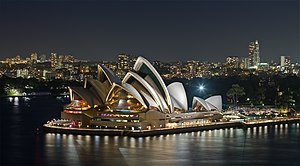 Image via Wikipediaby J. Mark Dangerfield, PhD
Image via Wikipediaby J. Mark Dangerfield, PhDSydney, Australia is a fantastic city. There are water views everywhere thanks to a harbor that folds its way for more than 40km inland from its ocean entrance. The beaches, all 62 of them, are fabulous and the water is warm most of the year. And if you tire of the beach there is a world heritage forest wilderness an hour away in the Blue Mountains.
Not surprisingly there are roughly 4 million Sydney residents. Most live in suburbs spread across a metropolitan area of 12,145 km2, leaving plenty of space between and in the dwellings, and open areas to enjoy. Almost everyone is within walking distance of a park. Add some sun, those infamous beaches and you have the ideal city.
Visitors also like Sydney. Each year the city plays host to close to 10 million tourists, 3 million of them from overseas.
The place is so popular that in the last decade around half a million people have decided to become Sydneysiders, the local name for residents. This is roughly 1,000 new inhabitants per week, a growth rate of 15%, a little higher than the rate of increase in the overall population of Australia over the same period.
In addition to the arrivals social trends have seen families become smaller, splitting faster than they are merging. And whilst youngsters are staying at home longer, they eventually want to move out.
Over the coming decades Sydney will need to supply 640,000 new homes just to keep up with projected demand.
Whilst developers may be smiling, this number has had planners in state and local government waving their hands in the air. Even in a place with so much space, such a sustained influx places huge pressure on infrastructure, especially transport.
It also generates environmental challenges.
The supply of water, sewage services and power must all increase as the city grows. And there comes a point where delivery systems for utilities are past their sell-buy date. They cannot be upgraded or expanded anymore and a whole new system is needed.
Or, as with Sydney and its sewage release to the open ocean, the system is no longer acceptable.
640,000 homes and the roads, railways, shops and public spaces that support them need space. Some will be squeezed in amongst the existing suburbs; others will be green field developments. Conservation of natural habitat is a challenge when the concreted area expands.
In Sydney the built up area is encroaching on fertile agricultural land that has traditionally supplied a large proportion of the horticultural produce consumed by the city's residents and those 10 million visitors. Planners must make the difficult choice between food production and living space. Good choices need local input and a clear regional strategy.
Sydney has a few quirky issues too, such as what to with a resident population of grey-headed flying foxes, an endangered but nuisance species of fruit bat the size of a small cat, roosting in the botanic gardens that sit in the shadow of the CBD skyscrapers.
Then there is the real environmental issue of the city's footprint. Water, energy, food and waste cannot all be generated within the Sydney basin. A much bigger land area is needed to supply the resources and places are needed to dispose of waste.
There is also the issue of greenhouse gas emissions from lifestyles that use fossil fuel based electricity and transport.
It is a long list of challenges that each place pressure on the integrity of the environment.
Sydney is a moderate sized city by modern standards, similar to Phoenix, Arizona. It is half the size of Chennai, a third the size of London, a quarter that of Shanghai and a blip compared to Tokyo, the largest agglomeration in the world, at 34 million inhabitants.
The significant statistic is that there are at least 70 cities in the world that have larger populations than Sydney. Urbanization is a big deal.
The environmental issue for real is that we have to have this urbanization. The world population of 7 billion will peak at between 9 and 12 billion and, to help retain an environment that can support them; we probably want most of these extra people to live in cities.
Attention to how we make these cities livable and how we can manage their environmental footprints should be a priority for us all.
J. Mark Dangerfield, PhD is a scientist, consultant and educator with a different take on our environmental challenges. Read more of his work at http://www.climate-change-wisdom.com or grab a copy of his book 'Awkward news for Greenies and everyone else' at http://www.createspace.com/3379619
Article Source: http://EzineArticles.com/?expert=J._Mark_Dangerfield_Ph.D.
Article Source: http://EzineArticles.com/6340806

No comments:
Post a Comment